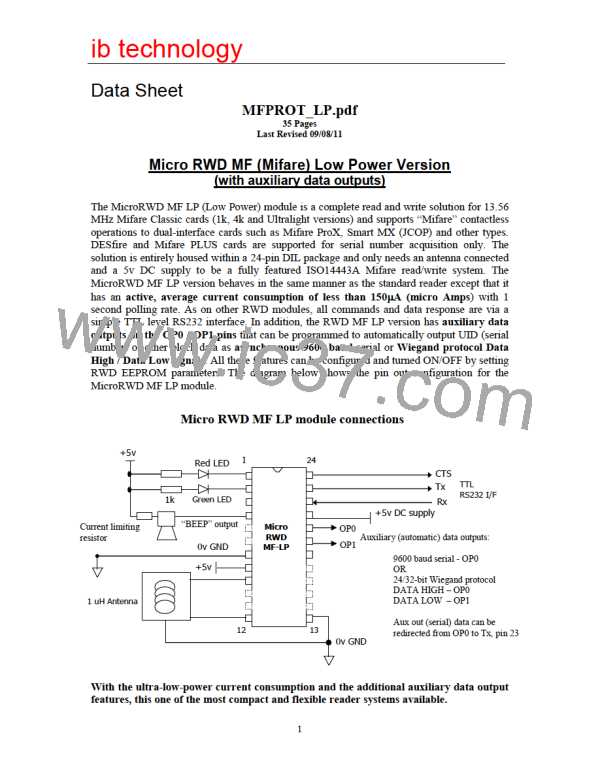ib technology
Mifare Applications and Security
The Mifare “classic” family is the pioneer and market leader in contactless smart card
technology operating in the 13.56 MHz frequency range with read/write capability. The
Mifare technology was originally designed for Electronic-Purse applications for public
transport systems and was a benchmark for the ISO 14443A standard. The cards have up to
40 separate memory sectors or “purses” (on Mifare 4k card) that can be individually locked
and unlocked for access. In addition, the high speed communication of the 13.56 MHz
interface allows for quick increment/decrement operations that are required for rapid ticketing
or e-purse applications. Typical transaction time is less than 100ms for read/modify/write
operations. The multiple memory sectors allow for different service providers to use the same
Mifare card with complete independence and security, the Ultralight card has only one sector
and is designed for single use or disposable applications due to it’s low cost.
Because Mifare was designed originally for Electronic-Purse applications, a very high level of
security was essential to prevent fraud. Each transaction is started with a mutual three pass
authentication procedure according to the ISO 9798-2 standard. RF communication is
protected from replay attack and data communication between RWD and card is encrypted
according to the Philips triple-DES CRYPTO1 algorithm. Separate sets of two security keys
for each memory sector (or application) ensure that service providers have complete security
control over their individual sector. The high level of data integrity for the 106 kbaud RF
communication is achieved by combining a special patented modulation technique, 16 bit
CRC, parity bit coding, bit counting, channel monitoring and an anticollision algorithm.
Finally, the RWD device itself stores up to 32 security keys that the service provider can
change and use for their applications. These keys are non-volatile and cannot be read back
further ensuring system security.
Even though the Mifare technology is ideally suited to e-purse uses, each card has a unique
serial number at the beginning of it’s memory that makes the technology suitable for almost
any application requiring large and secure read/write memory areas. Typical applications
could include:-
Access Control, Automatic Fare Collection, Bus/Train/Airline ticketing, Electronic Purse,
Vending, Loyalty / Membership Schemes, ID cards, Time and Attendance, Asset
Tracking, Gambling, Electronic Keys, Logistics, Road Tolling, Payphones, Park and Ride
Schemes, pre-paid metering.
IB Technology’s design philosophy has created the “Universal RFID Socket” so that different
technologies such as the 125 kHz MicroRWD (Hitag and EM Marin) modules, QT (Quad
Tag) module and the 13.56 MHz MicroRWD Mifare and I.CODE modules are the same
physical size, have the same pinout and share common serial commands. This concept allows
users to select and migrate between different RFID technologies according to the specific
features they require with the minimum of design changes.
(Hitag, Mifare and I.CODE are registered trademarks of NXP/Philips Semiconductors N.V)
32

 RFSOLUTIONS [ RFSOLUTIONS.LTD ]
RFSOLUTIONS [ RFSOLUTIONS.LTD ]